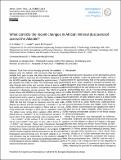| dc.contributor.author | Ridley, David Andrew | |
| dc.contributor.author | Heald, Colette L. | |
| dc.contributor.author | Prospero, J. M. | |
| dc.date.accessioned | 2014-09-04T15:12:23Z | |
| dc.date.available | 2014-09-04T15:12:23Z | |
| dc.date.issued | 2014-06 | |
| dc.date.submitted | 2014-04 | |
| dc.identifier.issn | 1680-7324 | |
| dc.identifier.uri | http://hdl.handle.net/1721.1/89170 | |
| dc.description.abstract | Dust from Africa strongly perturbs the radiative balance over the Atlantic, with emissions that are highly variable from year to year. We show that the aerosol optical depth (AOD) of dust over the mid-Atlantic observed by the AVHRR satellite has decreased by approximately 10% per decade from 1982 to 2008. This downward trend persists through both winter and summer close to source and is also observed in dust surface concentration measurements downwind in Barbados during summer. The GEOS-Chem model, driven with MERRA re-analysis meteorology and using a new dust source activation scheme, reproduces the observed trend and is used to quantify the factors contributing to this trend and the observed variability from 1982 to 2008. We find that changes in dustiness over the east mid-Atlantic are almost entirely mediated by a reduction in surface winds over dust source regions in Africa and are not directly linked with changes in land use or vegetation cover. The global mean all-sky direct radiative effect (DRE) of African dust is −0.18 Wm−2 at top of atmosphere, accounting for 46% of the global dust total, with a regional DRE of −7.4 ± 1.5 Wm−2 at the surface of the mid-Atlantic, varying by over 6.0 Wm−2 from year to year, with a trend of +1.3 Wm−2 per decade. These large interannual changes and the downward trend highlight the importance of climate feedbacks on natural aerosol abundance. Our analysis of the CMIP5 models suggests that the decreases in the indirect anthropogenic aerosol forcing over the North Atlantic in recent decades may be responsible for the observed climate response in African dust, indicating a potential amplification of anthropogenic aerosol radiative impacts in the Atlantic via natural mineral dust aerosol. | en_US |
| dc.description.sponsorship | Massachusetts Institute of Technology (Charles E. Reed Faculty Initiative Fund) | en_US |
| dc.description.sponsorship | National Science Foundation (U.S.) (AGS-1238109) | en_US |
| dc.description.sponsorship | National Science Foundation (U.S.) (AGS- 0962256) | en_US |
| dc.description.sponsorship | National Science Foundation (U.S.) (NASA NNX12AP45G) | en_US |
| dc.language.iso | en_US | |
| dc.publisher | Copernicus GmbH on behalf of the European Geosciences Union | en_US |
| dc.relation.isversionof | http://dx.doi.org/10.5194/acp-14-5735-2014 | en_US |
| dc.rights | Creative Commons Attribution | en_US |
| dc.rights.uri | http://creativecommons.org/licenses/by/3.0/ | en_US |
| dc.source | Copernicus Publications | en_US |
| dc.title | What controls the recent changes in African mineral dust aerosol across the Atlantic? | en_US |
| dc.type | Article | en_US |
| dc.identifier.citation | Ridley, D. A., C. L. Heald, and J. M. Prospero. “What Controls the Recent Changes in African Mineral Dust Aerosol Across the Atlantic?” Atmospheric Chemistry and Physics 14, no. 11 (2014): 5735–5747. | en_US |
| dc.contributor.department | Massachusetts Institute of Technology. Department of Civil and Environmental Engineering | en_US |
| dc.contributor.department | Massachusetts Institute of Technology. Department of Earth, Atmospheric, and Planetary Sciences | en_US |
| dc.contributor.mitauthor | Ridley, David Andrew | en_US |
| dc.contributor.mitauthor | Heald, Colette L. | en_US |
| dc.relation.journal | Atmospheric Chemistry and Physics | en_US |
| dc.eprint.version | Final published version | en_US |
| dc.type.uri | http://purl.org/eprint/type/JournalArticle | en_US |
| eprint.status | http://purl.org/eprint/status/PeerReviewed | en_US |
| dspace.orderedauthors | Ridley, D. A.; Heald, C. L.; Prospero, J. M. | en_US |
| dc.identifier.orcid | https://orcid.org/0000-0003-2894-5738 | |
| dc.identifier.orcid | https://orcid.org/0000-0003-3890-0197 | |
| mit.license | PUBLISHER_CC | en_US |
| mit.metadata.status | Complete | |
